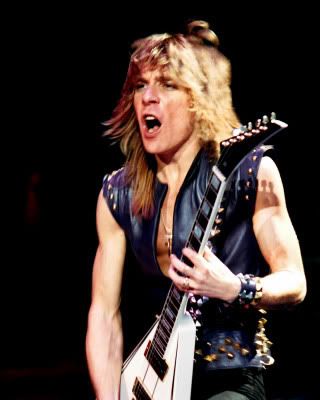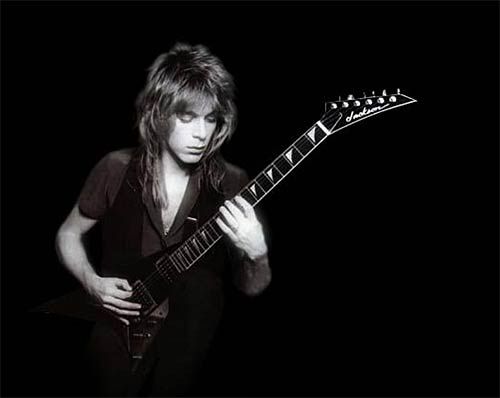Here are 80 of The Top 100 Guitarists of the Rock Era*:
100. Mick Barr, Orthrelm
99. Jerry Cantrell, Alice in Chains
98. Mike Bloomfield, Paul Butterfield Blues Band
97. Danny Kirwan, Fleetwood Mac
96. Daron Malakian, System of a Down
95. Sam Totman, Dragonforce
94. Kerry King, Slayer
93. Robbie Krieger, Doors
92. Ted Nugent
91. Jason Becker, David Lee Roth
90. John 5, David Lee Roth, Marilyn Manson
89. Jake E. Lee, Ratt, Ozzy Osbourne
88. Michael Wilton, Queensryche
87. James Munky Shaffer, Korn
86. Uli Jon Roth, Scorpions
85. Richie Sambora, Bon Jovi
84. Rick Derringer, McCoys, Edgar Winter Group, solo
83. Dave Mason, Traffic, solo
82. Warren DeMartini, Ratt, Whitesnake
81. Synyster Gates, Avenged Sevenfold
80. Jack White, the White Stripes
79. Alex Lifeson, Rush
78. Chuck Schuldiner, Death
77. Neil Young, Crosby, Stills, Nash & Young, solo
76. C.C. DeVille, Poison
75. Gary Rossington, Lynyrd Skynyrd, Rossington-Collins Band
74. Peter Frampton, Humble Pie, solo
73. Neil Giraldo, Pat Benatar
72. Keith Richards, Rolling Stones
71. Michael Schenker, Scorpions, UFO, Michael Schenker Group
70. Tom Morello, Rage Against the Machine
69. Neal Schon, Santana, Journey
68. Vivian Campbell, Whitesnake, Def Leppard, Thin Lizzy
67. Dave Mustaine, Metallica, Megadeth
66. Danny Gatton
65. Timo Tolkki
64. Allen Holdsworth
63. Dave Murray, Iron Maiden
62. Nuno Bettencourt, Extreme
61. Ace Frehley, Kiss, solo
60. Reb Beach, 28 years
59. Allen Collins, Lynyrd Skynyrd, Rossington Collins Band
58. Kurt Cobain, Nirvana
57. John Petrucci, Dream Theatre
56. Richie Kotzen
55. Michael Angelo Batio, Holland, the Michael Angelo Band, Nitro
54. Scotty Moore, Elvis Presley
53. Rick Nielsen, Cheap Trick
52. Fast Eddie Clarke, Motorhead
51. Vinnie Moore, UFO
50. Joe Walsh, James Gang, solo, and Eagles
49. Roy Buchanan
48. Chuck Berry
47. Rory Gallagher, solo
46. Steve Lukather, Toto
45. Tommy Bolin, Deep Purple
44. Frank Zappa, Mothers of Invention, solo
43. Gary Moore, Thin Lizzy, solo
42. Stephen Stills, Buffalo Springfield, Crosby, Stills & Nash, solo
41. Mick Ronson, David Bowie, solo
40. The Edge, U2
39. Mike Campbell, Tom Petty & the Heartbreakers
38. Derek Trucks, Allman Brothers Band
37. Zakk Wylde
36. Dimebag Darrell
35. Lee Ranaldo
34. Kirk Hammett, Metallica
33. John Frusciante, Red Hot Chili Peppers
32. Slash, Guns N' Roses
31. Albert Lee
94. Kerry King, Slayer
93. Robbie Krieger, Doors
92. Ted Nugent
91. Jason Becker, David Lee Roth
90. John 5, David Lee Roth, Marilyn Manson
89. Jake E. Lee, Ratt, Ozzy Osbourne
88. Michael Wilton, Queensryche
87. James Munky Shaffer, Korn
86. Uli Jon Roth, Scorpions
85. Richie Sambora, Bon Jovi
84. Rick Derringer, McCoys, Edgar Winter Group, solo
83. Dave Mason, Traffic, solo
82. Warren DeMartini, Ratt, Whitesnake
81. Synyster Gates, Avenged Sevenfold
80. Jack White, the White Stripes
79. Alex Lifeson, Rush
78. Chuck Schuldiner, Death
77. Neil Young, Crosby, Stills, Nash & Young, solo
76. C.C. DeVille, Poison
75. Gary Rossington, Lynyrd Skynyrd, Rossington-Collins Band
74. Peter Frampton, Humble Pie, solo
73. Neil Giraldo, Pat Benatar
72. Keith Richards, Rolling Stones
71. Michael Schenker, Scorpions, UFO, Michael Schenker Group
70. Tom Morello, Rage Against the Machine
69. Neal Schon, Santana, Journey
68. Vivian Campbell, Whitesnake, Def Leppard, Thin Lizzy
67. Dave Mustaine, Metallica, Megadeth
66. Danny Gatton
65. Timo Tolkki
64. Allen Holdsworth
63. Dave Murray, Iron Maiden
62. Nuno Bettencourt, Extreme
61. Ace Frehley, Kiss, solo
60. Reb Beach, 28 years
59. Allen Collins, Lynyrd Skynyrd, Rossington Collins Band
58. Kurt Cobain, Nirvana
57. John Petrucci, Dream Theatre
56. Richie Kotzen
55. Michael Angelo Batio, Holland, the Michael Angelo Band, Nitro
54. Scotty Moore, Elvis Presley
53. Rick Nielsen, Cheap Trick
52. Fast Eddie Clarke, Motorhead
51. Vinnie Moore, UFO
50. Joe Walsh, James Gang, solo, and Eagles
49. Roy Buchanan
48. Chuck Berry
47. Rory Gallagher, solo
46. Steve Lukather, Toto
45. Tommy Bolin, Deep Purple
44. Frank Zappa, Mothers of Invention, solo
43. Gary Moore, Thin Lizzy, solo
42. Stephen Stills, Buffalo Springfield, Crosby, Stills & Nash, solo
41. Mick Ronson, David Bowie, solo
40. The Edge, U2
39. Mike Campbell, Tom Petty & the Heartbreakers
38. Derek Trucks, Allman Brothers Band
37. Zakk Wylde
36. Dimebag Darrell
35. Lee Ranaldo
34. Kirk Hammett, Metallica
33. John Frusciante, Red Hot Chili Peppers
32. Slash, Guns N' Roses
31. Albert Lee
30. Mark Knopfler, Dire Straits
29. Pete Townshend, Who
28. Glen Tipton, Judas Priest
27. Marty Friedman, Megadeth
26. Dick Dale, Ventures,
25. David Gilmour, Pink Floyd
24. Adrian Smith, Iron Maiden
23. Angus Young, AC/DC
22. Paco DeLucia
21. Paul Gilbert, Mr. Big
In this range, and actually in the Top 50, a guitarist who plays less than ten years is not going to be included unless he was very special. The elite guitarist at #20 was:
#20: Randy Rhoads, Ozzy Osbourne, Quiet Riot
8 years as an active guitarist

Rhoads first picked up a guitar (a Gibson acoustic) at age six. After playing acoustic for six years, he graduated to the electric guitar. Randy formed a cover band called Violet Fox at the age of 14 with brother Kelle on drums. The group performed songs by the Rolling Stones, Alice Cooper and David Bowie, among others at the Grand Salon at Musonia, mother Delores's music school.
After Violet Fox broke up, Rhoads taught his best friend Kelly Garni to play bass, and the pair formed Quiet Riot when Rhoads was 16 years old. Kevin DuBrow auditioned for vocalist in the group and was accepted, while drummer Drew Forsyth had played with Rhoads and Garni in the past. Quiet Riot began playing in small bars in Hollywood and eventually landed gigs at famous Whisky a Go-Go and the Starwood in Los Angeles.
Although Quiet Riot could not get a major recording contract, they were able to secure a deal with Japanese label CBS/Sony Records and released Quiet Riot and Quiet Riot II in Japan.

In 1979, Ozzy Osbourne was putting together a new band and became aware of Rhoads. Randy auditioned with his Les Paul guitar and a practice amp, warming up by playing some riffs. Rhoads immediately got the job in November 1979.
The band was known as The Blizzard of Ozz and recorded their self-titled album. Rhoads' neo-classical guitar work was one of the bright spots on the album. The group released two singles from the album but neither did well. The Blizzard of Ozz toured Great Britain in 1980-81.

The group released Diary of a Madman in 1981. While on tour, Randy took lessons from classical guitarists and entertained thoughts of leaving rock for a few years to earn a degree in classical guitar. Rhoads was attracting considerable attention for his amazing guitar work. Guitar Player magazine honored him by giving him the Best New Talent award. Jackson Guitars created a signature model for him., the Jackson Randy Rhoads. Rhoads was given a prototype, a black offset V hardtail, but died before the guitar went into production.
Rhoads played his final show March 18, 1982 at the Knoxville Civic Coliseum in Knoxville, Tennessee. The band then traveled to a festival in Orlando, Florida, stopping off in Leesburg, Florida for the night. The property contained a small airstrip with small helicopters and planes with houses belonging to Jerry Calhoun and tour bus driver Andrew Aycock. Aycock was a licensed pilot and talked keyboardist Don Airey into taking a test flight in a '55 Beechcraft Bonanza the next morning.
After landing, Aycock took Rhoads and Rachel Youngblood up on another flight. While in the air, Aycock tried to "buzz" the tour bus while the other group members were asleep. The first two attempts succeeded, but on the third pass, the left wing clipped the back of the tour bus, tore open the fiberglass roof, and sent the plane spiraling. The plane cut the top of a pine tree and crashed into the garage of a nearby mansion. The plane burst into flames and all three aboard were killed instantly.
The coroner found that Aycock had cocaine in his system at the time of the accident. The National Transportation Safety Board determined that Aycock's medical certificate had expired and his required biennial flight review was overdue.
Rhoads' funeral was at the First Lutheran Church in Burbank, California.
In 1987, Osbourne released the live album Tribute, with most of the songs from a live performance in Cleveland, Ohio. Two tracks, "Goodbye to Romance" and "No Bone Movies", were recorded during the UK tour.

Marshall Amplification released the 1959RR at NAMM 2008 as a tribute to Rhoads. The amplifier is an all-white Marshall Super Lead 100 watt head modeled after Randy's, including the special high-gain modification Randy had requested when he visited the Marshall factory in 1980.
Jackson Guitars released an exact replica of Randy's original white "shortwing" V guitar. In 2004, Randy was inducted into the Guitar Center Rock Walk. In 2010, Gibson Guitars announced a new custom signature guitar modeled after Rhoads' 1974 Les Paul Custom.

Despite his youth and limited work, Rhoads is considered to be one of the greatest guitarists of all-time by numerous sources, including Inside the Rock Era. He has appeared on the covers of many guitar magazines and his influence was felt by guitarists such as Yngwie Malmsteen, Paul Gilbert, Kirk Hammett, Zakk Wylde, Dimebag Darrell, John Petrucci, Tom Morello, Michael Angelo Batio and Jake E. Lee, all members of The Top 100 Guitarists of the Rock Era*.
Rhoads had a range where he could play slow, warm, perfectly executed solos to fast, bending, energetic solos. His amazing guitar work in songs like "Crazy Train" and "Revelation" illustrates his gift. Randy's tap-picking, fast fingers, perfect pitch bends, hemmer-ons, slides and use of effects was done perfectly. Rhoads brought classical themes into his guitar playing, as Ritchie Blackmore had done before him, and it's no secret that Randy planned to take classical guitar lessons to further his development before his life was tragically cut short. Had he lived, he would have had influence on nearly every guitarist today. And likely ranked in the Top 10.
Rhoads played the Gibson 1974 Les Paul Custom, the Jackson Black Signature Rhoads with a fixed bridge, the Jackson White Concorde and the Karl Sandoval Flying V.
Rhoads favored Marshall amps--he had three 100W 1959SLP heads and Marshall 1960A cabinets loaded with Altec 417-8H speakers. He did use the Peavey Standard head while with Quiet Riot.
Randy used the Dunlop Crybaby Wah, the Roland RE-201 Space Echo, the Kork echo and the distortion, EQ, Flanger and Chorus pedals from MXR.

Rhoads has won several awards, including being named one of Guitar World's 50 Fastest Guitarists. Unfortunately, Rhoads did not have the combination of experience and groundbreaking ability that would be necessary to rank in the Top 10. But he was a guitar wonder with limitless potential, and Randy ranks #20 for the Rock Era*...
No comments:
Post a Comment
Note: Only a member of this blog may post a comment.